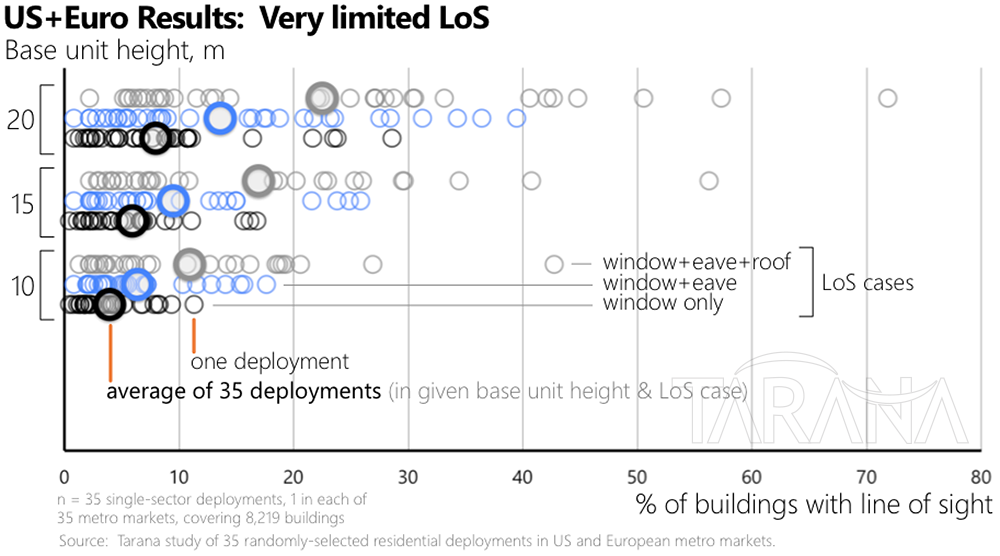We all know continued growth in consumer and business demand for bandwidth is outstripping the peak speed and capacity supply of copper-based fixed access infrastructure (driven by the usual suspects: 4K video, immersive online gaming, video presence, cloud apps, remote work, and so on). The prohibitive cost of filling this supply/demand gap with fiber is also well understood. Wireless fixed access is a potential solution, but industry veterans bearing scars from past attempts to address this problem with wireless will note that current industry excitement about new prospects for gigabit wireless access could be ignoring some equally harsh realities.
The Tarana team has had the privilege of working closely over the past seven years with a number of tier 1 wireline service providers who have seen this copper exhaustion problem coming. Given the intrinsically poor economics of fiber, they were keenly interested in seeing what a new approach to gigabit-class wireless access might yield. While our respect for their strategic interests (not to mention tight non-disclosure agreements) prevents us from answering that question here just yet, we thought it would be helpful to present a high-level view of the key deployment challenges and resulting functional requirements that have emerged consistently from that work.
We should note before getting into it that proper and complete radio system design must take into account a large and complex set of simultaneous and interrelated technical, operational, and economic considerations for any large-scale application. This can be an involved topic to cover from the bottom up, so for sake of readability, we’ll hit the highlights here and invite separate conversations about the next layers down.
4K-Ready Service
It almost goes without saying, but a viable gigabit wireless access (GWA) solution equipping service providers for their next-generation access strategies needs to deliver fiber-class bandwidth — which our customers have guided us to understand, for desired deployment topologies (on which more later), at least ~1 Gbps peak data rates per subscriber, ~10 Gbps aggregate capacity per base station, and support for hundreds of users per sector (and a couple thousand per base station).
Non Line of Sight (NLoS) Operation
Because this operational imperative drives a number of other requirements, as we’ll see below, it’s best to assess at the outset how often base station and remote radios will be able to “see” each other clearly in the actual use case. For residential broadband, the unfortunate fact is “rarely.” Our study of a representative sample of U.S. and European residential neighborhoods, conducted at customers’ behest, indicates that a base unit mounted at a neighborhood-aesthetics-compatible light-pole or rooftop height will have clear line of sight to on average just under 10 percent of the residences within a practical minimum cell radius of 500m (see Figure 1). Trees taller than the houses they ornament and shade are nearly ubiquitous, even in relatively dry climates, where palms are the wireless-disrupting foliage of choice. This, along with obstructions from closer-range target dwellings themselves as well as terrain details, limits clean line of sight (LoS) connections to typically at most a handful of homes nearest the base unit.

Figure 1: Typical availability of line of sight in practical residential GWA deployments
High Spectral Efficiency
For radio systems to achieve high bandwidth in NLoS installations, they need multipath reflections and/or diffraction around or over obstructions, from which they can collect and reconstruct their signals. The inescapable physics of wireless propagation constrain such systems to operate in roughly the 1 to 10 GHz bands — i.e. the spectrum where reflections and diffraction actually work well. As their typical auction prices indicate, these bands are prime real estate, both because of their ideal characteristics and already high occupancy by military, public safety, and commercial mobile networks. Due to high demand for this spectrum, a viable GWA solution must therefore achieve a large step-function increase — of 10x or more — over current wireless networks in the amount of bandwidth it can carry in a given channel size per base site in order to deliver 4K-worthy services with workable spectrum economics.
Immunity to Interference from Other Co-Channel Networks
Because most fixed operators do not have access to licensed spectrum, especially not in the required 1–10 GHz mobile-compatible bands, a viable GWA solution must also maintain high bandwidth reliably and consistently despite pervasive interference in the typically congested unlicensed 5 GHz band, as well as in the 3 GHz CBRS band (in the U.S.) where interference may occur as well. This feature must involve rejection of interference in the channel of operation, not just the currently-common practice of evasive “channel adaptation,” the industry’s euphemism for attempting to solve the interference problem by running away from it to another, hopefully less busy, channel in the band. Channel adaptation works well in lightly-used bands, but in a congested area — such as a residential neighborhood or dense urban centers with numerous 5 GHz WiFi devices operating — it cannot be trusted to maintain reliable links. The ongoing transition in WiFi to 80 MHz channels makes the availability of cleaner channels in the 5 GHz band even more unlikely.
Uniform Service Offering throughout the Coverage Area
That a GWA solution needs to support the same service offering to every household in a coverage area may seem like another obvious point, but it needs to be made explicitly in the context of current radio networks. As we’ve all experienced on our smartphones, today’s networks deliver quite variable throughput as a function of location. In higher-density deployments, the issue is not the natural fall-off of signal strength with distance, but self-interference in the network. As we illustrate in simple (and not to scale) form in Figure 2, in a conventional radio network design like today’s 4G LTE (without automatic, active co-channel interference management), client devices near the midpoint between two base stations hear signals from both of them. Resolving the desired signal from this combination of signals gets harder, the closer they get to equal power, and as a result the signal can’t be used to carry as much information (in fact per-user LTE bandwidth can fall by factor of 100 at the cell edge) — making wireless resemble exhausted copper access infrastructure. Without uniform service throughout the coverage area, and the active co-channel interference management it requires, a GWA solution provides no improvement over the industry’s status quo, and a service that cannot be marketed successfully.

Figure 2: How not to deliver uniform servide (LTE example)
High Capacity Density
To provide uniform, high spectral efficiency throughout a network deployment, a viable GWA solution must manage co-channel interference for base stations in relatively close proximity as well. This allows base units to be deployed with enough density, and all in the same channel, to provide service in high market share and/or high residential density circumstances without imposing unachievable spectrum-use requirements.
Scalable Deployment
As a converse to requirement 5, the system must also support viable (low) costs per household served for larger cells and lower demand density. Fixed access operators work across a range of neighborhood household density, adoption, and market share profiles in their territory. To support profitable operation across that range, a GWA solution must deliver on the inherent advantage wireless solutions have over wireline — that they can be configured to make service available over a broad area with relatively light initial infrastructure investment and then in-filled as necessary over time as market share and demand rise. Our customers’ range expectations for GWA infrastructure are 500 to 1,000m for NLoS, and up to 2 km for near LoS.
Resiliency and Reliability under Changing Conditions
This requirement includes both changes in the radio environment as well as the “service environment”, i.e. the stochastic demand profile of the user base and shifting service commitments over time. In the RF environment, as another implication of the NLoS requirement, a viable GWA solution must maintain steady, reliable radio performance in the face of a wide variety of changing physical conditions in the environment that affect the radio channel — because much more than just the radio at the other end of the link is in each radio’s field of view. Through variations in signal absorption, reflection, and diffraction, essentially every physical feature of the landscape that can change — whether quickly or slowly — can have an effect, including foliage moving and fluttering in the wind, passing vehicles, foliage growth, seasonal decoration installations, new construction, and so on. A system’s adaptation to these changes must be essentially continuous, in order to handle the effects of the most rapid variations in the environment — particularly vehicular traffic and fluttering foliage — and maintain reliably stable performance.
On the bandwidth demand side, a GWA system must present the same kind of independence of overall medium capacity from users’ behavior exhibited by wireline solutions. In conventional wireless solutions, since multiple users’ radio signals interact with each other in destructive ways, the shifting nature of their demand profile can materially affect the overall capacity of the system from moment to moment, significantly complicating scheduling and the maintenance of service consistency. These complications must be avoided by maintaining wireline-like independence of users’ individual radio resources.
Trivial Planning and Installation
Installation cost and time are the Achilles’ heel of fiber. A viable GWA solution cannot present the same challenge. Without proper design that starts with the radios’ inherent capabilities, it is far too easy for wireless systems to become labor nightmares of a different but similarly uneconomic sort. Today’s cellular networks still require extensive network planning and simulation by a cadre of highly-trained professionals before initial installations, and then similarly extensive re-planning whenever capacity infill is required. At the client end, several prior attempts at GWA over the years have failed at the “truck roll” stage — requiring precise placement and alignment of the remote radio unit on the home, all done by skilled and therefore too-expensive labor, and too often with multiple attempts. The good news is that any system that can fulfill requirements 1 through 7 will have the solid foundation of autonomous adaptive behaviors and self-alignment capabilities required to make planning and installation quite straightforward, given proper management system implementation.
Viable Overall Network Economics
The previous requirements made several references to solution viability and practical deployment metrics. These are all in the service of the summary requirement that a GWA solution must have overall network economics — the combination of capex for deployment and opex in ongoing operation — that represent a very material improvement over the outside-plant intensity of fiber, enabling competitive service pricing while yielding an attractive ROI.
The Complete Package, in the General Case
As we noted above, a proper and complete radio system design solution to the fixed access problem must take into account a large and complex set of simultaneous and interrelated technical, operational, and economic considerations for large-scale application. While it’s tempting to pursue solutions that relax one or more of these requirements for the sake of simplifying the challenge and creating the illusion of progress, or to narrow the scope of applicability to a small subset of a wireline operator’s range of deployment conditions, taking these shortcuts will yield solutions that fall well short of addressing access operators’ urgent needs.
Steven Glapa is the vice president of marketing at Tarana Wireless.
Filed Under: Infrastructure




